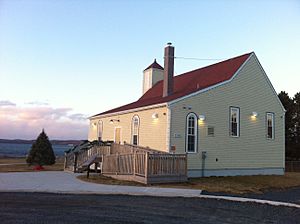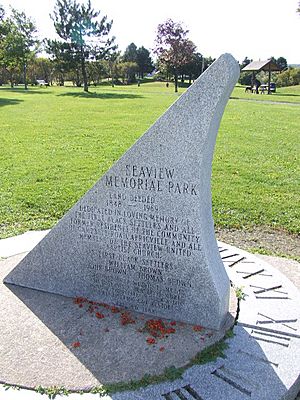Africville Apology facts for kids
The Africville Apology was a special statement made on February 24, 2010. The City of Halifax, Nova Scotia said sorry for forcing people out of their homes in Africville. Africville was a community of Black Nova Scotians that was eventually destroyed.
Contents
Why Did Africville Get Relocated?
In the 1940s and 1950s, governments in Canada wanted to move people from areas they called "slums." They planned to move these people to better homes. The land they left behind would then be used for businesses and factories.
Africville had a big fire in 1947, which burned several houses. After this, people talked about moving the community. In 1957, a report called the Stephenson Report suggested relocation. Official plans to move Africville residents started in 1961.
In 1962, Halifax leaders agreed to the relocation plan. A report called the Rose Report (published in 1964) promised help for residents. This help included free lawyers, social workers, job training, and education. Most leaders voted to approve the plan. The report did not explain what life would be like for residents in their new homes. However, it said the plan was for their own good.
Moving Homes and People
Most of the Africville residents were moved between 1964 and 1967. City workers helped them move. However, they used city dump trucks to move people's belongings. This made many people feel disrespected and hurt.
Moving caused many problems, like suspicion and arguments over land. Only 14 families had clear legal papers for their land. People without legal land rights received $500. They were also promised money for furniture, social help, and public housing. Young families could use this money to start fresh. But many older residents did not want to leave. They had strong emotional ties to their homes. Even though they were sad and felt cheated, it became harder to resist. More people accepted the move, and homes disappeared.
When Homes Were Torn Down
The city quickly tore down each house as soon as people moved out. The church in Africville was very important to the community. It was torn down at night in 1969 to avoid protests. The very last Africville home was destroyed on January 2, 1970.
Today, part of Africville is covered by a highway. This highway leads to the A. Murray MacKay Bridge. However, the waterfront area of Africville was not used for port development. This means the water's edge is still there.
How People Fought for Justice
People worked for over 25 years to fix the wrongs of the Africville relocation. The Africville Genealogy Society led many of these efforts.
In the 1980s, the City of Halifax created Seaview Memorial Park on the Africville site. This stopped any new buildings from being built there. Former Africville residents, like Eddie Carvery, held protests at the park for many years.
In 1989, a special exhibit about Africville traveled across Canada. It later became a permanent exhibit at Nova Scotia's Black Cultural Centre in Preston, Nova Scotia. In 2001, a report from the United Nations asked for money to be paid to the Africville community.
Music and Stories Remember Africville
Many musicians have told the story of Africville through their music. They hoped this would encourage governments to make things right.
- African-Canadian singer-songwriter Faith Nolan released an album called Africville in 1986.
- In 1996, jazz pianist Joe Sealy released a CD called Africville Suite. It won a Juno Award in 1997. The CD has twelve songs about places and activities in Africville. Joe Sealy's father was born there.
- In 1997, Canadian jazz pianist Trevor Mackenzie released an album. It was a tribute to the neighborhood where his father grew up.
- In 2007, the band Bucket Truck released a music video. Their song described the events that happened in Africville.
- Also in 2007, the Canadian hip hop group Black Union released a song about Africville. The music video was filmed in Seaview Park.
Films and Books Tell the Story
Many films and plays have been made to remember the struggles of Africville.
- Remember Africville (1991) is a documentary film. It won an award for best documentary.
- Consecrated Ground (1998) is a play by George Boyd. It tells a fictional story about the Africville eviction.
- The story of Africville has greatly influenced the writer George Elliott Clarke.
- Last Days in Africville (2006) by Dorothy Perkyns is a fictional book. It tells the story of a young girl in Africville when it was destroyed.
- Stolen From Africville (2008) is a documentary film. It follows the lives of people who were forced to leave Africville.
- Africaville (2020) by Jeffrey Colvin is a novel. It tells the story of several generations of a family from Africville.
Taking Action in Politics
In May 2005, Maureen MacDonald, a member of the Nova Scotia government, introduced a bill. It was called the Africville Act. This bill asked for a formal apology from the Nova Scotia Government. It also asked for public meetings about Africville's destruction. Finally, it wanted a fund to protect Africville's history and help former residents.
Halifax mayor Peter Kelly offered land, money, and other services. He offered to help build a copy of the Seaview African United Baptist Church. The Africville Genealogy Society asked for some changes to this offer. They wanted more land and the chance to build affordable housing near the site. In 2002, the Africville site was declared a national historic site. This means it is an important place in Canada's history.
The Official Apology
In February 2010, the Halifax Council officially approved the Africville Apology. The Government of Canada also announced $250,000 for the Africville Heritage Trust. This money would help design a museum and build a copy of the community church.
On February 24, Mayor Peter Kelly made the Africville Apology. This was part of a $4.5-million agreement to make up for the past. He officially said sorry for the eviction. Mayor Kelly said:
We apologize for the heartache experienced at the loss of the Seaview United Baptist Church, the spiritual heart of the community, removed in the middle of the night. We acknowledge the tremendous importance the church had, both for the congregation and the community as a whole. We realize words cannot undo what has been done, but we are profoundly sorry and apologize to all the former residents and their descendants.
On July 29, 2011, the city changed the name of Seaview Park back to Africville Park. This happened at the yearly Africville Family Reunion. The Seaview African United Baptist Church, which was torn down in 1969, was rebuilt in the summer of 2011. It now serves as a church and a place to learn about Africville's history. The church officially opened on September 25.
Rev. Rhonda Britten, a leader in the African-Nova-Scotian community, welcomed the agreement. She said it was time to move forward:
I know that there are some among us who are wounded, and some among us who bear those scars. But, in spite of all of that, the victory has been won. We cannot continue to feed our children the bitter pills, we must give them the pills of love. We must plant in them the seeds of unity and victory. That is the only way.
See Also



